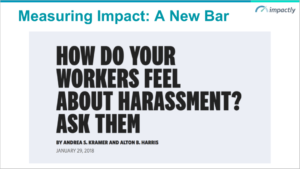
The Rise of the Workplace Climate Survey
The Facts
Q&A
Thanks to new legislation in California, New York and Delaware, more employers will train on sexual harassment & discrimination prevention in 2019 than ever before.
Previous legislation in California, Connecticut and Maine focused on workplace sexual harassment training requirements for managers and supervisors. As such, compliance training content has been centered around managing within the law rather than prevention best practices (e.g. bystander intervention).

This focus on managing within the law and compliance also defined how sexual harassment & discrimination prevention training initiatives have been measured. Specifically, completion or participation numbers have been the key metric for HR in reporting the success or failure of an annual training initiative.
Question: Has your CEO or board ever asked you if your harassment prevention training is working?
Thanks to the ever increasing public pressure from the #metoo movement, along with #metoo legislation like SB 1343 in California and the Stop Sexual Harassment in NYC Act that requires all employees be trained, the question is now being asked with more frequency.
Question: *If* your CEO or board asked you if your harassment prevention training is working, what would you say?
The Rise of the Workplace Climate Survey
An article published in Harvard Business Review in January, 2018 introduced a very simple, and approachable way to answer that question: ask your employees [Workplace Climate Surveys].

There are 5 key benefits to conducting a Workplace Climate Survey:
- Better understand your training investment: mandatory sexual harassment prevention training may be one of your only, if not the only, company wide training initiatives. As such, defending your annual training strategy and budget will be an ongoing challenge. Need to upgrade training vendors? Need approval for booster training? Climate Survey data will help demonstrate ROI and get buy-in with key executives.
- Identify gaps in knowledge: What constitutes harassment? Where do you report? How do you report? Ensure that employees are retaining key information in your training.
- Identify risks and opportunities: Invariably there will be areas for improvement-- and in some instances, there will be clear risk areas (e.g. 55% of female employees do not feel empowered to report an incident of sexual harassment).

- Demonstrate commitment: Sexual harassment & discrimination training is often viewed as a check the box initiative. Irrespective of the quality of your training, by implementing a Workplace Climate Survey, you’re signaling to your employees that you want to identify opportunities to improve.
- Benchmark: Measuring your year-over-year improvement is important. But to really understand what “good” looks like, it’s important to compare your Workplace Climate Survey scores against industry peers. This will also help in getting executive and board level support for future training initiatives.
What types of questions are included in a Workplace Climate Survey?
There are typically four question types (at Impactly, we focus on three of the four).
- Demographic: Capturing basic (and anonymous) demographic data enables you to reveal gender and role-based disparities in knowledge and climate within your organization. We recommend: Gender, seniority, tenure.
- Knowledge: How do you report harassment? Where do you report it? Measuring for knowledge gain allows you to both measure the efficacy of your existing training, and identify opportunities for booster (supplementary) training or education.
- Climate: Do your employees feel empowered to report an incident of sexual harassment? Do they think reporting will be taken seriously? Anonymous climate questions, especially when compared against demographic data, can reveal important, often-hidden patterns in your workforce.
- Incidents: Have you experienced sexual harassment? Have you witnessed discrimination at work? Anonymous incident reporting can help your organization identify and address major issues. While not specifically actionable (you won't know who is reporting), there's a lot your organization can (should) do to address any wide scale issues. Before you add Incident Reporting questions to your climate survey, you'll want to make sure your CEO and General Counsel have an action plan for addressing issues that may be revealed.
Now what?
Once you’ve conducted a Workplace Climate Survey, you’ll want to dig into the data to identify opportunities for additional education or policy changes. To be clear, by conducting this type of survey, you're creating an expectation of continuous improvement. Deep breathe! Harassment and discrimination prevention is a forever-initiative.
The alternative? Don't ask the questions. Measure success by participation numbers. Hire a good employment lawyer. Hope for the best. (Note: This is not our recommendation).

If you want help in administering a Workplace Climate Survey, we have a free platform you can use: link here.
The Impactly team is launching a free national Workplace Climate Survey in January for companies and higher ed institutions. It’s a free resource that enables year over year performance tracking and industry benchmarking. Irrespective of how you train — whether you switch vendors every year — whether you do in-person for some employees and virtual for others– our recommendation is that you institute our survey (or one like it).
How we developed the questions?
These questions were developed first based on the AAU and White House Climate Surveys that were developed and deployed for Higher Ed institutions (for students) in 2015.
We then worked with HR, legal and prevention experts to convert these questions into a workplace relevant format.
Have more questions about our Workplace Climate Survey? Read more here>>
